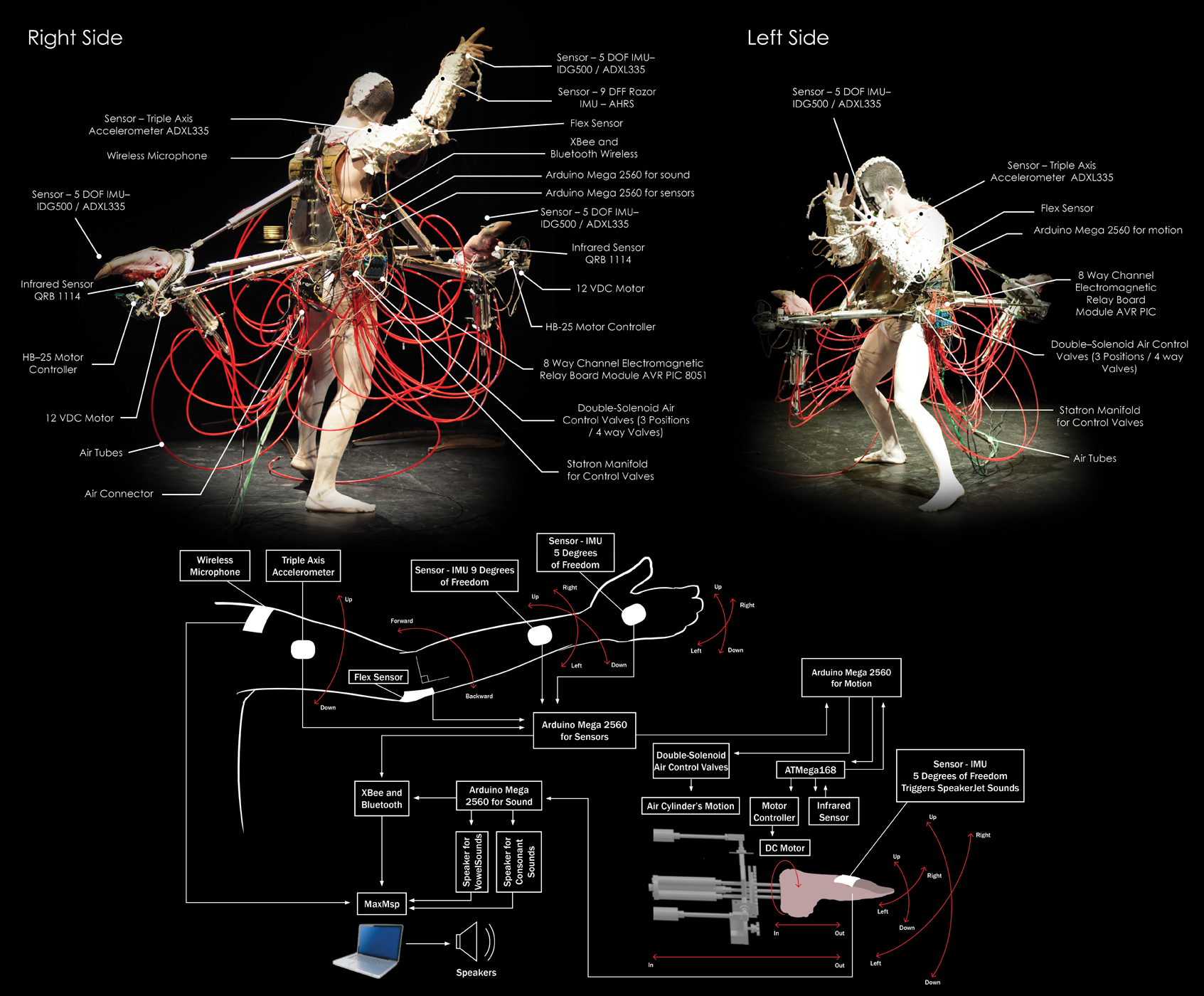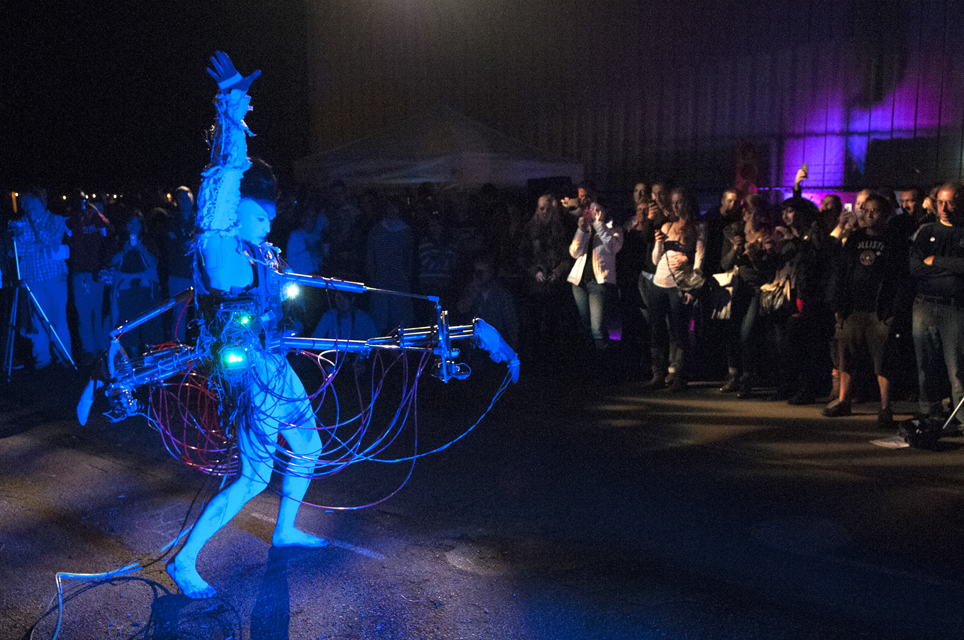Doo Sung Yoo
Independent Artist
Vishtauroborg is a compound word, which is formed from “Vishnu,” “Minotaur,” “Robot,” “Organ,” and “Cyborg.” Vishtauroborg is a conceptual human–animal–machine hybrid-cyborg, which creates a dancing performance with the performer wearing robotic machines on his/her chest and back. The machines, dressed in cow tongues, react to the dancing performer’s choreographic gestures with its own mechanical motions, as well as emit computational speech sounds based on these real–time reactions.

Vishtauroborg (version 2.6: Reaction), 2012, Doo Sung Yoo, robotic devices and cow tongues, ©doosungyoo.com
Vishtauroborg’s mechanical motion system modifies the “Seven Degrees of Freedom,” which is actuated by digital sensors on the performer’s arms. [1] The artificial speech sound system generates consonants and vowels sounds from sensor data, which is created by the cow tongues’ wiggling motions. These motions are triggered by the performer’s hands’ motion sensors, which simultaneously manipulate the performer’s own voice sounds and live background music. These systems illustrate exceeding human body limitations, such as the expanded degrees of arm movements and the expansion of the human vocal range. Vishtauroborg’s visual and sound performance celebrates the technological power that enables humans to redesign his/her body forms, following the idea of a ‘posthuman,’ who ultimately ascends to be a more advanced species or who moves beyond the conventional parameters of human nature. [2]

Vishtauroborg (version 2.0: Reembody) – Electronic materials and process, 2011, Doo Sung Yoo, robotic devices and cow tongues, ©doosungyoo.com
Vishtauroborg is also a metaphor for the philosophical concept of philosopher Dr. Max More’s ‘Technological Self –Transformation.’ [3] Vishtauroborg illustrates that the augmented human could have a morphological self–freedom, which also parallels the notion of new media art theorist Dmitry Bulatov’s ‘Metabola,’ the transformative characteristic of the current techno–biological artwork in contemporary art. [4] The biological materials (the cow tongues and the human body) are transformed and modified (physically, not genetically) by the electronic and computational systems in Vishtauroborg’s body.
Vishtauroborg is visually, conceptually, and technically similar to Stelarc’s robotic performances, Ping Body, [5] and Exoskeleton, [6] and Bill Vorn’s Grace State Machines. [7] These projects probe how robotics can relate to the human body. However, Vishtauroborg suggests more theatrical and artistic visual narratives by interweaving different media: choreography, costume design, makeup design, sound design, and lighting, to enhance the artistic articulations. Vishtauroborg’s version 3.1 involves the styles of contemporary choreography: Kazuo Ohno’s butoh [8] and Merce Cunningham’s improvisations, [9] which mingle with the mechanical motions for rhythmic harmony. In addition, the costume design and makeup design fabricate the androgynous characteristics of a hybrid–human. The soundscape, comprising of live futuristic music and robotic speech sounds (all originating from the dancing performer and the machine on the performer,) embodies the new reach of human ability through technological augmentation.
Vishtauroborg is continually evolving into different forms and implementing new technology in order to push the evolution of human artistic expression.

Vishtauroborg (version 3.1: Incompatibility), 2012, Doo Sung Yoo, robotic devices and cow tongues, ©doosungyoo.com
References:
1. “Robotic Technology – Arms,” Electronics Teacher, accessed March 6, 2013, http://www.electronicsteacher.com/robotics/robotics-technology/arms.php
2. “Transhumanist FAQ,” Humanity+, accessed March 5, 2013, http://humanityplus.org/philosophy/transhumanist-faq/
3. Max More, “The Overhuman in the Transhuman,” Journal of Evolution and Technology 21, no. 1 (2010): 1–4, accessed March 11, 2013, http://jetpress.org/v21/more.htm
4. Dmitry Bulatov, “A Post-Biological Artwork,” InterTekst, May 24, 2011, http://www.intertekst.com/236_artykul.html?jezyk=en&id_artykul=236
5. “Stelarc Ping Body,” Media Art Net, accessed March 10, 2013, http://www.medienkunstnetz.de/works/ping-body/
6. “Exoskeleton,” on Stelarc’s official website, accessed March 10, 2013, www.stelarc.org
7. “Grace State Machines,” on Bill Vorn’s official website, accessed March 7, 2013, http://billvorn.concordia.ca
8. “Kazuo Ohno,” Kazuo Ohno Dance Studio, accessed March 8, 2013, http://www.kazuoohnodancestudio.com/english/kazuo/
9. “Merce Cunningham Dance Company: World Heritage Tour – Paris,” Culturekiosque, accessed March 8, 2013, http://www.culturekiosque.com/dance/reviews/cunningham_wht704.html
Bio:
Doo Sung Yoo explores hybrid art, interweaving interdisciplinary media for creating new art forms. His current focus is on surpassing the human body with technological augmentations illustrated in his ongoing project series, the Organ-Machine Hybrids, in which mechanical bodies and the human body are combined with disembodied animal organs and electronic devices.
www.doosungyoo.com


